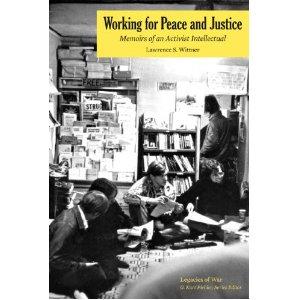
Lawrence Wittner, Professor Emeritus at the State University of New York at Albany, has written a delightful memoir of his life as a public intellectual and activist. Working for Peace and Justice is a compelling chronicle not just of an interesting man living in interesting times, but also how he worked to improve those times, and how that work has enriched his life as well as those close to him. (Disclosure – Professor Wittner serves as a member of the Peace Action board of directors, both for the national organization and our New York State affiliate. He co-edited, along with Glen Stassen, Peace Action’s 50th anniversary book, Peace Action: Past, Present and Future, for which I was one of the authors.)
Perhaps because I admire and like Larry Wittner so much, I really enjoyed this coming of age story of a shy, sensitive, intellectual boy from Brooklyn who went on to become a civil rights, labor, and peace activist, and the authoritative scholar of the global nuclear disarmament movement (his Struggle Against the Bomb trilogy is the gold standard in the field). While I enjoyed that “political” part of the book, Wittner’s personal journey is very interesting too, as he overcame numerous personal and professional obstacles to become a much-respected and well-liked stalwart in the fields of academia and peace, labor and social justice activism.
As a prolific and widely published author, it’s not surprising Professor Wittner’s writing talents would serve him well in telling his life story. What drew me in to this book was the effortless weaving of his personal and family story with his work in the civil rights, labor, anti-war, and nuclear disarmament movements that shaped so many in his generation.
In recounting his personal journey, Wittner exhibits an egoless, frank, analytical self-awareness that I’ve encountered in very few memoirs (too many are nakedly self-serving). He matter-of-factly describes difficult episodes and relationships, and even unflattering character traits of his own. Wittner’s memory and attention to detail are impressive (maybe too much so; he recounts a mildly embarrassing faux pas of mine regarding an expired passport that I wish he’d forgotten!).
One example of this is the story of Wittner’s struggle for job security and acceptance in academia, as he was on multiple occasions fired, denied tenure, discriminated against, or just plain given a raw deal over his progressive political views. And these professional travails were often accompanied by the apparent mismatch in values and unhappiness with his first wife, Patty.
And yet Wittner paints a clear picture of someone who had confidence in, and took succor from, his passion for teaching, research and writing, his political activism, and from nourishing relationships with family and friends. His joy at the birth and growth of his daughter Julia (and later his relishing of grandfatherhood) is a very pleasant thread throughout the book, as is his special partnership with his second wife, Dorothy.
As I know Wittner best as a peace activist, not a scholar (though I use his books like the Bible they are for the nuclear disarmament and peace movements), I enjoyed tales of his civil rights work in the deep South in the early 1960s (with some great personal encounters with less enlightened Southerners thrown in), in the movement against the Vietnam War, and in labor struggles in academia and beyond.
One of my favorite stories was of Wittner’s arrest at an anti-apartheid sit-in action in Albany in 1985. As he was handcuffed and led smiling to the police van, his friends saw him and started a chant of “Free Larry! Free Larry!” (There’s a great picture of him in the police van among the many interesting photographs in the book.)
Larry Wittner’s life and work are inspiring on their own, but he recounts them in such a frank, open manner that he has crafted a real page-turner. Working for Peace and Justice takes the reader along on a joyful ride of discovery through the life of a model citizen/scholar/activist. Wittner demythologizes, by the simple telling of his life story, the fields of academia and activism, two related fields that sorely need it, and that sorely need more people to understand and embrace them.
It is highly recommended reading for peace and justice movement activists and scholars, particularly young folks wanting a first-hand account of the seminal movements of the last 50 years, or for anyone wishing to read a gripping story of a life well-lived in tumultuous times.
